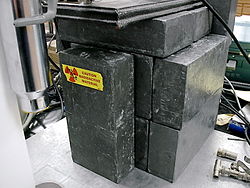Wikijunior:The Elements/Lead


What does it look, feel, taste, or smell like?
[edit | edit source]
Lead is a soft, heavy metal. When freshly cut it is bright silver in color, but it tarnishes in the air to a dull grey. It is a soft and malleable metal. It does not have an odor.
How was it discovered?
[edit | edit source]Lead has been used for at least 7000 years. There have been lead pipes from Roman times found today.
Where did its name come from?
[edit | edit source]In Latin, lead was called plumbum; in Rome, lead was used for plumbing. This is why the symbol for lead is Pb. The English word lead comes from the German word lot, which means "weight". Lead is very heavy and is commonly used in weights.
Where is it found?
[edit | edit source]Lead is usually found in ores, like galena (which is lead sulfide, PbS.)
Did You Know?
- Pencil "lead" has never been made out of lead; instead, it is made out of graphite, a form of carbon.
- Lead was associated with the planet Saturn.
- The word "plumbing" comes from the Latin word for lead, plumbum.
What are its uses?
[edit | edit source]
Lead has high density (it is very heavy for its size) and fairly inexpensive, so it is commonly used to make weights such as fishing sinkers and dumbbells. It is also used to make bullets and other ammunition. Its high density also makes lead an effective shield to block radiation. For example, before taking dental x-rays the technician will put a lead apron over the patient's body to prevent unnecessary radiation exposure.
Because lead melts at a fairly low temperature, it is mixed with other metals to make solder, used to join pipes or electrical wires. But lead solder is being replaced with other types of solder that are safer and better for the environment (such as silver solder, which contains silver instead of lead, or brazing, which uses pure copper metal.)
Lead was used in some paints to make it dry faster and last longer. However, the dust that naturally comes off of painted walls is toxic when it contains lead, so leaded paint is no longer used for painting houses (but older buildings with leaded paint pose a risk).
Lead used to be added to gasoline to help boost its octane and prevent engine knocking. But this has been phased out in most countries because it ruins catalytic converters (an important part of a car's smog-reduction system), and to avoid environmental and health problems.
Lead-acid batteries are the oldest type of rechargeable battery, and are still in common use in cars, boats, and electric vehicles such as golf carts. They are heavier than most other batteries, but can supply high current and are relatively inexpensive.
Lead is also used in products from China. In 2007, concern was raised with consumers when products were recalled; and even today lead can get into consumer products.
Is it dangerous?
[edit | edit source]Lead compounds are poisonous, as lead binds with other atoms in your body rather than iron and other metals. This leads to weird cell functions that can lead to illness and, if untreated, death. Lead poisoning can be called saturnism, plumbism, or painter's colic.
Even at levels not deadly, lead causes unwelcome changes in behavior, including learning disabilities and loss of impulse control.